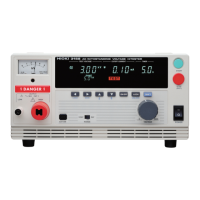26
────────────────────────────────────────────────────
3.3 Setting the "SETTING" State
────────────────────────────────────────────────────
3.3.1 Setting the Comparative Voltage Value
Comparative voltage value: 3.50 kV
Comparative voltage value: OFF
NOTE
・
You can select whether you want to check the output-voltage when the test starts or ends.
(Starting a test with default settings:) (See Section 4.9)
If a comparative-voltage value is to be set, value settings must be made. Once a
comparative-voltage value is set, a test will not start until the output voltage reaches
the comparative-voltage range, which is
±
5% of the comparative-voltage value
(output voltage:
≦
1kV:
±
50 V). TEST will flicker until the value reaches the
value range. If the value fails to reach the value range within approximately five
seconds, FAIL will light along with UPPER and LOWER and the test will quit
with the FAIL judgment. Also, in the same way the test will quit with the FAIL
judgment if it is outside of the standard voltage range during the test. If a
comparative-voltage value is not to be used, press the
ON/OFF
key to turn the
setting for that value OFF. Any voltage value can then be output in the TEST state.
(1) If no flashing cursor is displayed in the READY state, press either the
/
key to display the cursor while the comparative voltage value is lit.
(2) Change the comparative voltage value using the
/ keys. The value
changes in 0.01 kV increments. To change the value by 0.10 kV, press
SHIFT
+ / keys.
The comparative voltage value can be set from 0.00 kV to 5.00 kV.
If a comparative voltage value is not to be used, press the
ON/OFF
key to turn
the setting for that value OFF.
(3) When settings are complete, press the
STOP
key.
(4) In the READY state, press the
START
key to output the measured voltage. If
the value fails to reach the value range within approximately five seconds, the
unit returns to the READY state. During those five seconds, use the output-
voltage knob to set the output voltage to the comparative-voltage value.
(5) When the output voltage is equal to the comparative-voltage value, terminate the
settings for the comparative-voltage value.
If the test time is set to OFF, the settings for the comparative-voltage value will
become invalid. Therefore, when the output-voltage settings are made, it is advisable
to set the test time to OFF.

